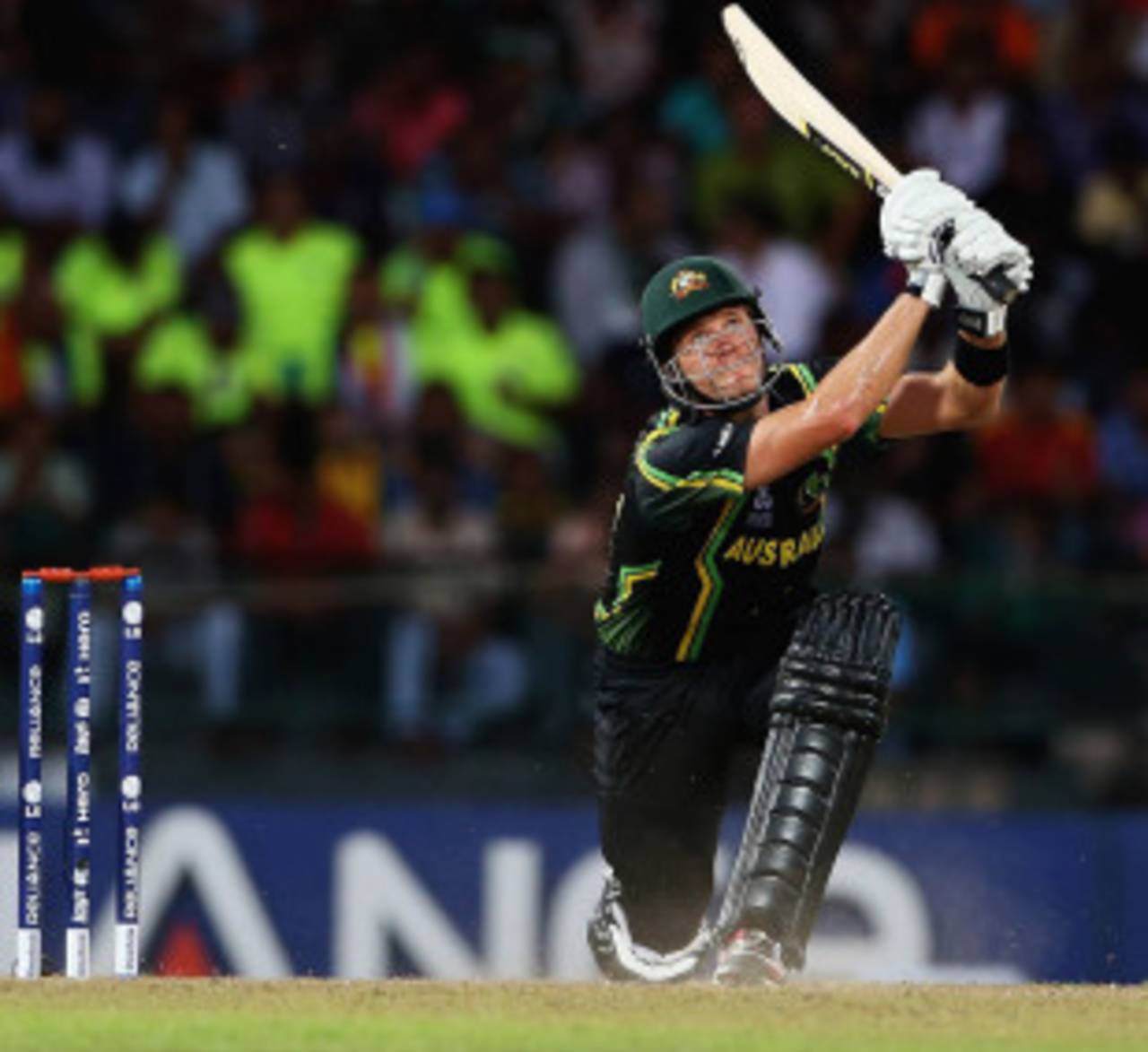The low arts of Shane Watson
His ability to get down and under the ball has been key to his success on the subcontinent
Aakash Chopra
03-Oct-2012

Watson: under and onward • ICC/Getty
It was a typical low, slow subcontinental pitch; a left-arm spinner with a round-arm action was operating, and the ball was only marginally short on middle and leg - the kind that forces you to be a little wary of the low bounce and makes you offer a straight bat instead of a horizontal one. Most batsmen, including ones from the subcontinent who grew up on these surfaces, would happily dab the delivery into a vacant on-side area and be satisfied with the outcome - mostly a single or a two. Years of batting on these surfaces have taught these men to bring out the horizontal bat shots only when the ball is really short and they are 100% sure of the bounce. Unlike when you play with a straight bat, where you can check your shot and convert an aggressive shot into a defensive prod even at the last second, once you've committed to a horizontal bat shot, there's no looking back. You're forced to execute it for good or ugly.
All of this only seems to be of academic interest when Shane Watson is batting, for he dispatches every short ball deep into the stands on the on side, even on these pitches. Where others are busy protecting their pads and wickets from the low bounce, he has found a way not just to make contact every single time but also to get under, getting elevation. How does he do it so efficiently?
Watson's trigger moment is among the unique facets of his batting. He goes deep into the crease with his back leg and keeps the toes of his front foot mobile, barely touching the ground. In doing so, he transfers his body weight completely onto the back foot just before the bowler releases the ball. This is, in fact, the antithesis of what the coaching manual recommends, which is that the batsman should distribute his body weight equally between both feet - the rationale being that equal distribution of weight makes both forward and backward movements easier.
In Watson's mode of operating, he prepares for the full ball first. Since the weight is already on the back foot, the forward movement becomes fluid, manifested in his long front-foot stride. But the moment the ball is even slightly short, instead of using a proper forward press to transfer the weight on to the front foot (like most other batsmen do, consuming precious time) before transferring it to the back foot again, he digs his front toe into the ground and uses that movement to transfer the weight and then swivels on to the back foot. In the process, he also clears the front leg quite nicely, which allows his arms a free swing. Watson's unique method of loading and unloading both feet to transfer weight gives him a precious few extra moments to pull even marginally short balls without fuss.
It isn't just Watson's ability to transfer his body weight that helps him get the ball to sail over the ropes so often. For such a tall man it must take special skill to not miss horizontal bat shots often on pitches where the ball stays alarmingly low. Watson manages to do so in large part by collapsing his back knee on almost every shot he plays. This helps him get under the ball and find elevation. To hit the ball in the air while playing horizontal bat shots, the bat must not go above the bounce of the ball in the backlift. It's incredible to see how low Watson goes by dropping his back knee and hands to get under the low bounce.
Watson has turned the fundamentals of batting on their head and is still hugely successful. It is widely believed that cricket is primarily a side-on game, and batting more so. It is believed that if both a batsman's shoulders are square-on while he plays strokes through the off side off the front foot, he is doomed. It is also thought that a straight drive can only be hit effectively with a straight bat.
Watson not only shows both his shoulders square-on, on almost every shot he plays, including the straight drive, he also plays with a vertically straight bat only against balls that are too full to be played with a slightly anguled or almost horizontal bat. Under normal circumstances, he should miss more often than not, but his back knee comes to his rescue. While playing a sweep, it's advised to drop the back knee, which helps you to stay really low, prevents you from going off-balance, and helps watch the ball closely. Watson follows the same principles, but does so even when playing down the ground. Staying low while playing all the shots off the front foot make him successful even on subcontinental pitches.
Collapsing the back leg has negative implications too. For starters, it makes it difficult to hit the ball straight, for your weight, instead of being on top of the ball, stays somewhere in between and you end up dragging the ball squarish on off-side shots. Somehow Watson has managed to take care of that too, which makes his adjustment quite extraordinary.
Finally, the secret to his clean hitting is the shape he maintains during and after hitting those big shots. Even while he plays outrageous strokes, like the flat-batted swipe over the bowler's head, he manages to stay quite composed. His arms, shoulders and torso are always firm, rarely losing shape.
Watson's unique way of playing makes it difficult for bowlers to find the right length and lines to bowl to him.
Former India opener Aakash Chopra is the author of Out of the Blue, an account of Rajasthan's 2010-11 Ranji Trophy victory. His website is here and his Twitter feed here